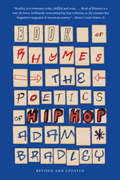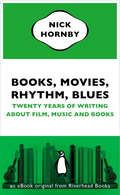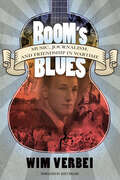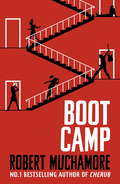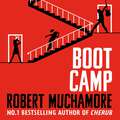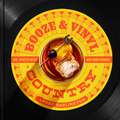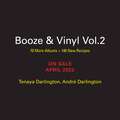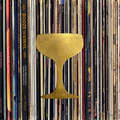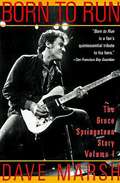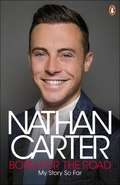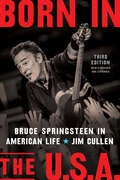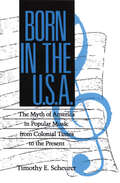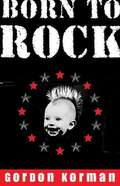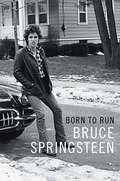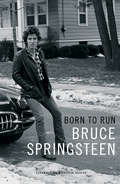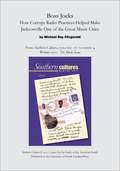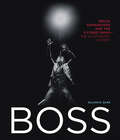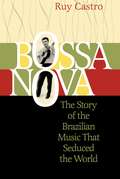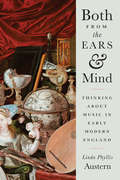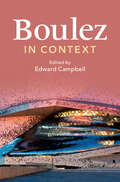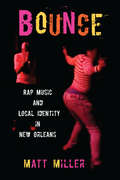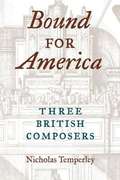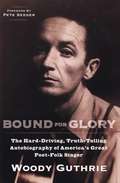- Table View
- List View
Book of Rhymes: The Poetics of Hip Hop
by Adam BradleyIf asked to list the greatest innovators of modern American poetry, few of us would think to include Jay-Z or Eminem in their number. And yet hip hop is the source of some of the most exciting developments in verse today. The media uproar in response to its controversial lyrical content has obscured hip hop's revolution of poetic craft and experience: Only in rap music can the beat of a song render poetic meter audible, allowing an MC's wordplay to move a club-full of eager listeners.Examining rap history's most memorable lyricists and their inimitable techniques, literary scholar Adam Bradley argues that we must understand rap as poetry or miss the vanguard of poetry today. Book of Rhymes explores America's least understood poets, unpacking their surprisingly complex craft, and according rap poetry the respect it deserves.
Books, Movies, Rhythm, Blues
by Nick HornbyA new collection of nonfiction writing on culture from the bestselling author of High Fidelity. Books, Movies, Rhythm, Blues brings together the best of Nick Hornby's non-fiction pieces on film and tv, writers and painters and music, and including one exceptional fragment of autobiography. With subject matter ranging from the Sundance Festival to Abbey Road Studios, from P.G. Wodehouse to The West Wing, these are pieces that 'were written for fun, or because I felt I had things to say and time to say them, or because the commissions were unusual and imaginative, or because ... I was being asked to go somewhere I had never been before.'
Boom's Blues: Music, Journalism, and Friendship in Wartime (American Made Music Series)
by Wim VerbeiBoom's Blues stands as both a remarkable biography of J. Frank G. Boom (1920–1953) and a recovery of his incredible contribution to blues scholarship originally titled The Blues: Satirical Songs of the North American Negro. Wim Verbei tells how and when the Netherlands was introduced to African American blues music and describes the equally dramatic and peculiar friendship that existed between Boom and jazz critic and musicologist Will Gilbert, who worked for the Kultuurkamer during World War II and had been charged with the task of formulating the Nazi's Jazzverbod, the decree prohibiting the public performance of jazz. Boom's Blues ends with the annotated and complete text of Boom's The Blues, providing the international world at last with an English version of the first book-length study of the blues. At the end of the 1960s, a series of thirteen blues paperbacks edited by Paul Oliver for the London publisher November Books began appearing. One manuscript landed on his desk that had been written in 1943 by a then twenty-three-year-old Amsterdammer, Frank (Frans) Boom. Its publication, to which Oliver gave the title Laughing to Keep from Crying, was announced on the back jacket of the last three Blues Paperbacks in 1971 and 1972. Yet it never was published and the manuscript once more disappeared. In October 1996, Dutch blues expert and publicist Verbei went in search of the presumably lost manuscript and the story behind its author. It only took him a couple of months to track down the manuscript, but it took another ten years to glean the full story behind the extraordinary Frans Boom, who passed away in 1953 in Indonesia.
Boot Camp: Book 2 (Rock War #2)
by Robert MuchamoreJay, Summer, Dylan and their bands are headed for boot camp at uber-glamorous Rock War Manor. It's going to be six weeks of mates, music and non-stop partying as they prepare for stardom.But the rock-star life of music festivals and glitzy premieres isn't all it's cracked up to be. Can the bands hold it together long enough to make it through the last stage of the competition, or will there be meltdown?The second book in this spectacular series by the bestselling Robert Muchamore, author of CHERUB.
Boot Camp: Book 2 (Rock War #2)
by Robert MuchamoreJay, Summer, Dylan and their bands are headed for boot camp at uber-glamorous Rock War Manor. It's going to be six weeks of mates, music and non-stop partying as they prepare for stardom.But the rock-star life of music festivals and glitzy premieres isn't all it's cracked up to be. Can the bands hold it together long enough to make it through the last stage of the competition, or will there be meltdown?(P) Hodder Children's Books 2016
Booze & Vinyl Country: 100+ Spirited Music-and-Drink Pairings
by André DarlingtonRaise a glass to more than 60 of country music&’s biggest hit albums with this spirited collection of music and mood-setting drink recipes—a delightful companion to the bestselling listening party guide, Booze & Vinyl. Features more than 100 cocktail recipes! Together, craft cocktails and vinyl music create sonic imbibing adventures that are both deeply personal and fun to share with others. Saddle up and let Booze & Vinyl Country take you on a journey through the harmonies, heartbreaks, and highs of country music. Covering a range of favorite movements and styles, this is your guide to more than sixty of the most beloved country albums from the 1950s to the present. Each entry features &“liner notes&” on the album and two accompanying boozy beverage recipes that complement the music or mood, or connect the drink to the artist. Select food recipes and full-color photography throughout complete the experience. Among the albums featured: Moanin&’ the Blues (Hank Williams), Coal Miner&’s Daughter (Loretta Lynn), Give It Up (Bonnie Raitt), Jolene (Dolly Parton), Come on Over (Shania Twain), Fearless (Taylor Swift), Cowboy Carter (Beyoncé), D-I-V-O-R-C-E (Tammy Wynette), Charley Pride&’s 10th Album (Charley Pride), Stardust (Willie Nelson), Why Not Me (The Judds), No Fences (Garth Brooks), Everywhere (Tim McGraw), Golden Hour (Kacey Musgraves), One Thing at a Time (Morgan Wallen), John Prine (John Prine), The Mysterious Rhinestone Cowboy (David Allen Coe), American IV: The Man Comes Around (Johnny Cash), Weight of These Wings (Miranda Lambert).
Booze & Vinyl Vol. 2: 70 More Albums + 140 New Recipes
by Tenaya Darlington André DarlingtonA follow-up to the bestselling listening party guide, Booze & Vinyl, this is an all-new collection of groundbreaking music paired with mood-setting cocktails.Get set to party with 70 great records—organized by theme, from Rockin&’ to Beats, Mellow to Jazzy & Bluesy—spanning the 1950s to today. Each entry features liner notes on the album and two accompanying boozy beverage recipes that complement the music.Among the featured albums are: Are You Experienced? (The Jimi Hendrix Experience), Toys in the Attic (Aerosmith), Synchronicity (The Police), Jagged Little Pill (Alanis Morisette), The B52s (The B52s ), Gipsy Kings (The Gipsy Kings), Violator (Depeche Mode), Ready to Die (The Notorious B.I.G.), Play (Moby), Lemonade (Beyoncé), Coat of Many Colors (Dolly Parton), Goodbye Yellow Brick Road (Elton John), So (Peter Gabriel), Whitney Houston (Whitney Houston), Oops!...I Did it Again (Britney Spears), Getz/Gilberto (Stan Getz and João Gilberto), A Love Supreme (John Coltrane).
Booze & Vinyl: A Spirited Guide to Great Music and Mixed Drinks
by Tenaya Darlington André DarlingtonThe ultimate listening party guide, Booze and Vinyl shows you how to set the mood for 70 great records from the 1950s through the 2000s.From modern craft cocktails to old standbys, prepare to shake, stir, and just plain pour your way through some of the best wax ever pressed. Wickedly designed and featuring photography throughout, Booze & Vinyl is organized by mood, from Rock to Chill, Dance, and Seduce. Each entry has liner notes that underscore the album's musical highlights and accompanying "Side A" and "Side B" cocktail recipes that complement the music's mood, imagery in the lyrics, or connect the drink to the artist. This is your guide to a rich listening session for one, two, or more.Among the 70 featured albums are: Sgt. Pepper's Lonely Hearts Club, Purple Rain, Sticky Fingers, Born To Run, License to Ill, Appetite for Destruction, Thriller, Like a Virgin, Low End Theory, The Rise and Fall of Ziggy Stardust, Hotel California, Buena Vista Social Club, Back to Black, Pet Sounds, Vampire Weekend, and many more
Born for the Road: My Story So Far
by Nathan CarterNathan Carter has become Ireland's biggest country music star. He is heralded by many as reviving the country music genre and bringing it into the mainstream. He has sold out venues across the UK and Ireland, has landed his own primetime show, and is loved and respected by legions of fans across Ireland.But how did a lad from Liverpool accomplish all this before the age of 27?In his revealing and inspirational autobiography, Nathan reminisces about his music filled childhood, and growing up in Merseyside with his Liverpool-Irish family. From his first taste of showbiz at the tender age of four, to his success on the north of England club circuit and his subsequent relocation to Donegal, Nathan explores the twists of fate that took him to chart success and to become Ireland's adopted poster boy for country music.
Born in the U.S.A.: Bruce Springsteen in American Life, 3rd edition, Revised and Expanded (Music / Culture Ser.)
by Jim CullenPioneering the field of Springsteen scholarship when it first appeared in 1997, Born in the U.S.A. remains one of the definitive studies of Springsteen’s work and its impact on American culture. Moving beyond journalistic and biographical approaches, Jim Cullen situates the artist in a wider historical canvas that stretches from the Puritans to Barack Obama, showing how he has absorbed, refracted, and revitalized American mythology, including the American Dream, the work ethic, and the long quest for racial justice. Exploring difficult questions about Springsteen’s politics, he finds a man committed to both democratic and republican principles, as well as a patriot dedicated to revealing the lapses of a country he loves. This third edition of Born in the U.S.A. is fully revised and updated, incorporating discussion of Springsteen’s wide output in the 21st century. While addressing Springsteen’s responses to events like 9/11, it also considers the evolution of his attitudes towards religion, masculinity, and his relationship with his audience. Whether a serious Springsteen fan or simply an observer of American popular culture, Born in the U.S.A. will give you a new appreciation for The Boss.
Born in the U.S.A.: The Myths of America in Popular Music from Colonial Times to the Present (Studies in Popular Culture Series)
by Timothy E. ScheurerThis is the first study to explore fully the myth of America as reflected in the nation's popular music. Beginning with the songs of the Pilgrims and continuing through more than two centuries of history and music, Born in the U.S.A. shows the emerging American myth and gives a close reading of the compositions of songwriters as diverse as William Billings, Henry Clay Work, Irving Berlin, Woody Guthrie, Bob Dylan, and Bruce Springsteen.So that the full and diverse narrative of this complex nation might be recorded, this insightful study is focused both upon the national myth and upon the songwriters and performers representing subcultures and alternative viewpoints that are the text of America's story. Through hymnlike paeans and through discordant lamentations protesting the realities of the contemporary workaday world, popular music is an astonishing mirror of American history.
Born to Drum: The Truth About the World's Greatest Drummers—from John Bonham and Keith Moon to Sheila E. and Dave Grohl
by Tony Barrell“An engaging journey into the wild and wonderful world of drumming.”—CLEM BURKE, BlondieTo have a great band you need a great drummer. For the first time, Tony Barrell shines a long-overdue spotlight on these musicians, offering an exciting look into their world, their art, and their personalities. In Born to Drum, he interviews some of the most famous, revered, and influential drummers of our time—including Chad Smith, Ginger Baker, Clem Burke, Sheila E., Phil Collins, Nick Mason, Patty Schemel, Butch Vig, and Omar Hakim—who share astonishing truths about their work and lives. He investigates the stories of late, great drummers such as Keith Moon and John Bonham, analyzes many of the greatest drum tracks ever recorded, and introduces us to the world’s fastest and loudest drummers, as well as the first musician to pilot a “flying drum kit” onstage.Filled with fascinating insights into the trade and little-known details about the greats, Born to Drum elevates drummers and their achievements to their rightful place in music lore and pop culture.“As Born to Drum proves, there’s a lot more to be told about drums and drumming than the Rolls-Royce in the swimming pool and the pyro beneath the bass drum.”—NICK MASON, Pink Floyd“Everyone should read this book—especially if you’re not a drummer. A great insight into a great sport.”—Joey Kramer, Aerosmith
Born to Rock
by Gordon KormanLeo Caraway, president of the Young Republicans Club and a future Harvard student, has his entire future planned. But Leo is soon thrown for a loop when he discovers that the lead singer of punk rock's most destructive band is his biological father.
Born to Run
by Bruce Springsteen<P>"Writing about yourself is a funny business...But in a project like this, the writer has made one promise, to show the reader his mind. In these pages, I've tried to do this." --Bruce Springsteen, from the pages of Born to Run <P>In 2009, Bruce Springsteen and the E Street Band performed at the Super Bowl's halftime show. The experience was so exhilarating that Bruce decided to write about it. That's how this extraordinary autobiography began. <P>Over the past seven years, Bruce Springsteen has privately devoted himself to writing the story of his life, bringing to these pages the same honesty, humor, and originality found in his songs. He describes growing up Catholic in Freehold, New Jersey, amid the poetry, danger, and darkness that fueled his imagination, leading up to the moment he refers to as "The Big Bang": seeing Elvis Presley's debut on The Ed Sullivan Show. He vividly recounts his relentless drive to become a musician, his early days as a bar band king in Asbury Park, and the rise of the E Street Band. With disarming candor, he also tells for the first time the story of the personal struggles that inspired his best work, and shows us why the song "Born to Run" reveals more than we previously realized. <P>Born to Run will be revelatory for anyone who has ever enjoyed Bruce Springsteen, but this book is much more than a legendary rock star's memoir. This is a book for workers and dreamers, parents and children, lovers and loners, artists, freaks, or anyone who has ever wanted to be baptized in the holy river of rock and roll. Rarely has a performer told his own story with such force and sweep. Like many of his songs ("Thunder Road," "Badlands," "Darkness on the Edge of Town," "The River," "Born in the U.S.A.," "The Rising," and "The Ghost of Tom Joad," to name just a few), Bruce Springsteen's autobiography is written with the lyricism of a singular songwriter and the wisdom of a man who has thought deeply about his experiences. <P><b>A New York Times Bestseller</b>
Born to Run (edición en lengua española): Memorias
by Bruce SpringsteenLas memorias de Bruce Springsteen. «Escribir sobre uno mismo es algo muy curioso. [...]. Pero en un proyecto como este el escritor hace una promesa: mostrarle su mente al lector. Y eso es lo que he intentado hacer en estas páginas.»Bruce Springsteen, extracto de Born to Run En 2009, Bruce Springsteen y la E Street Band actuaron durante el intermedio de la Super Bowl. La experiencia fue tan maravillosa que Bruce se propuso escribir sobre ello. Así comenzó esta extraordinaria autobiografía. Durante los últimos siete años, Bruce Springsteen se ha dedicado a escribir en privado la historia de su vida, dotando a estas páginas de la misma honestidad, humor y originalidad que encontramos en sus canciones. Describe sus primeros años como chaval católico en Freehold, Nueva Jersey, en un ambiente donde la poesía, el peligro y la oscuridad alimentaban su imaginación, hasta que llega el momento que él denomina «el Big Bang»: cuando vio en televisión el debut de Elvis Presley en The Ed Sullivan Show. Nos cuenta vívidamente su incansable voluntad de convertirse en músico, sus primeros tiempos como rey de las bandas de bar en Asbury Park, y el ascenso de la E Street Band. Con un candor desarmante, cuenta también por vez primera las angustias personales que inspiraron sus mejores obras, y explica porqué la canción «Born to Run» revela mucho más de lo que pensábamos. Born to Run será una revelación para cualquiera que en algún momento haya disfrutado de Bruce Springsteen, pero estas páginas son mucho más que las memorias de una legendaria estrella de rock. Es un libro para trabajadores y soñadores, padres e hijos, amantes y solitarios, artistas, friquis, o para cualquiera que alguna vez haya anhelado ser bautizado en el sagrado río del rock'n'roll. Rara vez un intérprete ha contado su propia historia con tanta amplitud y fuerza. Como muchas de sus canciones («Thunder Road», «Badlands», «Darkness on the Edge of Town», «TheRiver», «Born in the USA», «The Rising» o «The Ghost of Tom Joad», por citar solo algunas), la autobiografía de Bruce Springsteen ha sido escrita con el lirismo de un autor de canciones único y con la sabiduría de un hombre que ha reflexionado hondamente sobre sus experiencias.
Boss Jocks: How Corrupt Radio Practices Helped Make Jacksonville One of the Great Music Cities
by Michael Ray Fitzgerald'Kickbacks from government vendors, jobs for cronies, sweetheart deals for contractors' were commonplace--'It may have been the most corrupt city in America.'"What happened when greedy promoters ran radio stations and the local concert scene? They brought the Beatles to Jacksonville, but they also brought payola, greed, and corruption.This article appears in the 2011 Music issue of Southern Cultures.Southern Cultures is published quarterly (spring, summer, fall, winter) by the University of North Carolina Press. The journal is sponsored by the University of North Carolina at Chapel Hill's Center for the Study of the American South.
Boss: Bruce Springsteen and the E Street Band—The Illustrated History
by Gillian G. GaarFind out how legendary musician Bruce Springsteen earned his monicker. There's only one Boss; his story is revealed here.Bruce Springsteen is a platinum-shifting, stadium-filling rock star, but he is also more nuanced than that. He is a man of the people, making conventional-and-proud-of-it rock music aimed at the American working class.A supreme songwriter, Springsteen is a rock 'n' roll legend, and this lavishly illustrated book is an examination of his life and music. A comprehensive overview of a fascinating and unique artist, Boss: Bruce Springsteen and the E Street Band - The Illustrated History is a tribute to Springsteen's body of work, from the rock anthem Born to Run to his sepia-toned analysis of working-class misery, The River. There's Springsteen's gnarly, Bonnie and Clyde-style tableaux Atlantic City, as well as his debunking of guys' yearnings for youthful Glory Days. Throughout it all, Springsteen has demonstrated that he knows how to create a classic track. Find out once and for all why his nickname is The Boss.
Bossa Nova: The Story of the Brazilian Music That Seduced the World
by Julian Dibbell Ruy CastroBossa nova is one of the most popular musical genres in the world. Songs such as "The Girl from Ipanema" (the fifth most frequently played song in the world), "The Waters of March," and "Desafinado" are known around the world. Bossa Nova--a number-one bestseller when originally published in Brazil as Chega de Saudade--is a definitive history of this seductive music. Based on extensive interviews with Antonio Carlos Jobim, Jo+o Gilberto, and all the major musicians and their friends, Bossa Nova explains how a handful of Rio de Janeiro teenagers changed the face of popular culture around the world. Now, in this outstanding translation, the full flavor of Ruy Castro's wisecracking, chatty Portuguese comes through in a feast of detail. Along the way he introduces a cast of unforgettable characters who turned Gilberto's singular vision into the sound of a generation.
Both from the Ears and Mind: Thinking about Music in Early Modern England
by Linda Phyllis AusternBoth from the Ears and Mind offers a bold new understanding of the intellectual and cultural position of music in Tudor and Stuart England. Linda Phyllis Austern brings to life the kinds of educated writings and debates that surrounded musical performance, and the remarkable ways in which English people understood music to inform other endeavors, from astrology and self-care to divinity and poetics. Music was considered both art and science, and discussions of music and musical terminology provided points of contact between otherwise discrete fields of human learning. This book demonstrates how knowledge of music permitted individuals to both reveal and conceal membership in specific social, intellectual, and ideological communities. Attending to materials that go beyond music’s conventional limits, these chapters probe the role of music in commonplace books, health-maintenance and marriage manuals, rhetorical and theological treatises, and mathematical dictionaries. Ultimately, Austern illustrates how music was an indispensable frame of reference that became central to the fabric of life during a time of tremendous intellectual, social, and technological change.
Both from the Ears and Mind: Thinking about Music in Early Modern England
by Linda Phyllis AusternBoth from the Ears and Mind offers a bold new understanding of the intellectual and cultural position of music in Tudor and Stuart England. Linda Phyllis Austern brings to life the kinds of educated writings and debates that surrounded musical performance, and the remarkable ways in which English people understood music to inform other endeavors, from astrology and self-care to divinity and poetics. Music was considered both art and science, and discussions of music and musical terminology provided points of contact between otherwise discrete fields of human learning. This book demonstrates how knowledge of music permitted individuals to both reveal and conceal membership in specific social, intellectual, and ideological communities. Attending to materials that go beyond music’s conventional limits, these chapters probe the role of music in commonplace books, health-maintenance and marriage manuals, rhetorical and theological treatises, and mathematical dictionaries. Ultimately, Austern illustrates how music was an indispensable frame of reference that became central to the fabric of life during a time of tremendous intellectual, social, and technological change.
Boulez in Context (Composers in Context)
by Edward CampbellPierre Boulez was a towering figure in contemporary music from the 1940s and 1950s to his death in 2016. This volume demonstrates his distinctive impact on new music and situates him within a wide range of contexts to enhance appreciation of the cultural embeddedness of his work. Successive sections consider his early life and education, his engagements with cultural, musical, literary and artistic modernism, his relationships with his modernist predecessors and contemporaries, and the intersections of his work with literature, visual art, mathematics, philosophy and technology. Contributors explore his various roles as composer, conductor, recording artist, writer, teacher and systems builder, as well as his role in French cultural politics, his move to Germany and the time he spent in the United States. This book is essential for students and educators but also accessible to a general audience interested in Boulez's legacy and his unique position in recent music history.
Bounce: Rap Music and Local Identity in New Orleans
by Matt MillerOver the course of the twentieth century, African Americans in New Orleans helped define the genres of jazz, rhythm and blues, soul, and funk. In recent decades, younger generations of New Orleanians have created a rich and dynamic local rap scene, which has revolved around a dance-oriented style called "bounce." Hip-hop has been the latest conduit for a "New Orleans sound" that lies at the heart of many of the city's best-known contributions to earlier popular music genres. Bounce, while globally connected and constantly evolving, reflects an enduring cultural continuity that reaches back and builds on the city's rich musical and cultural traditions. In this book, the popular music scholar and filmmaker Matt Miller explores the ways in which participants in New Orleans's hip-hop scene have collectively established, contested, and revised a distinctive style of rap that exists at the intersection of deeply rooted vernacular music traditions and the modern, globalized economy of commercial popular music. Like other forms of grassroots expressive culture in the city, New Orleans rap is a site of intense aesthetic and economic competition that reflects the creativity and resilience of the city's poor and working-class African Americans.
Bound for America: Three British Composers
by Nicholas TemperleyNicholas Temperley documents the lives, careers, and music of three British composers who emigrated from England in mid-career and became leaders in the musical life of Federal-era America. William Selby of London and Boston (1738-98), Rayner Taylor of London and Philadelphia (1745-1825), and George K. Jackson of London, New York, and Boston (1757-1822) were among the first trained professional composers to make their homes in America and to pioneer the building of an art-music tradition in the New World akin to the esteemed European "classical" music. Temperley compares their lives, careers, and compositional styles in the two countries and reflects on American musical nationalism and the changing emphasis in American musical historiography.
Bound for Glory
by Woody GuthrieBound for Glory is the autobiography of Woody Guthrie, the founder of modern American folk music. It is a funny, cynical, earthy and tragic account of his life in an Oklahoma oil-boom town, of the Depression that followed,and of his subsequent travels in, on,and under trains, in stolen cars and on his feet, round an America going rotten from the top downwards
